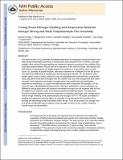Tuning Smart Microgel Swelling and Responsive Behavior through Strong and Weak Polyelectrolyte Pair Assembly
Author(s)
Costa, Eunice; Lloyd, Margaret M.; Chopko Ahrens, Caroline; Aguiar-Ricardo, Ana; Hammond, Paula T.
DownloadHammond_Tuning smart.pdf (1.993Mb)
PUBLISHER_POLICY
Publisher Policy
Article is made available in accordance with the publisher's policy and may be subject to US copyright law. Please refer to the publisher's site for terms of use.
Terms of use
Metadata
Show full item recordAbstract
The layer-by-layer (LbL) assembly of polyelectrolyte pairs on temperature and pH-sensitive cross-linked poly(N-isopropylacrylamide)-co-(methacrylic acid), poly(NIPAAm-co-MAA), microgels enabled a fine-tuning of the gel swelling and responsive behavior according to the mobility of the assembled polyelectrolyte (PE) pair and the composition of the outermost layer. Microbeads with well-defined morphology were initially prepared by synthesis in supercritical carbon dioxide. Upon LbL assembly of polyelectrolytes, interactions between the multilayers and the soft porous microgel led to differences in swelling and thermoresponsive behavior. For the weak PE pairs, namely poly(l-lysine)/poly(l-glutamic acid) and poly(allylamine hydrochloride)/poly(acrylic acid), polycation-terminated microgels were less swollen and more thermoresponsive than native microgel, whereas polyanion-terminated microgels were more swollen and not significantly responsive to temperature, in a quasi-reversible process with consecutive PE assembly. For the strong PE pair, poly(diallyldimethylammonium chloride)/poly(sodium styrene sulfonate), the differences among polycation and polyanion-terminated microgels are not sustained after the first PE bilayer due to extensive ionic cross-linking between the polyelectrolytes. The tendencies across the explored systems became less noteworthy in solutions with larger ionic strength due to overall charge shielding of the polyelectrolytes and microgel. ATR FT-IR studies correlated the swelling and responsive behavior after LbL assembly on the microgels with the extent of H-bonding and alternating charge distribution within the gel. Thus, the proposed LbL strategy may be a simple and flexible way to engineer smart microgels in terms of size, surface chemistry, overall charge and permeability.
Date issued
2012-07Department
Massachusetts Institute of Technology. Department of Chemical EngineeringJournal
Langmuir
Publisher
American Chemical Society (ACS)
Citation
Costa, Eunice, Margaret M. Lloyd, Caroline Chopko, Ana Aguiar-Ricardo, and Paula T. Hammond. “Tuning Smart Microgel Swelling and Responsive Behavior through Strong and Weak Polyelectrolyte Pair Assembly.” Langmuir 28, no. 26 (July 3, 2012): 10082–10090. © 2012 American Chemical Society.
Version: Author's final manuscript
ISSN
0743-7463
1520-5827